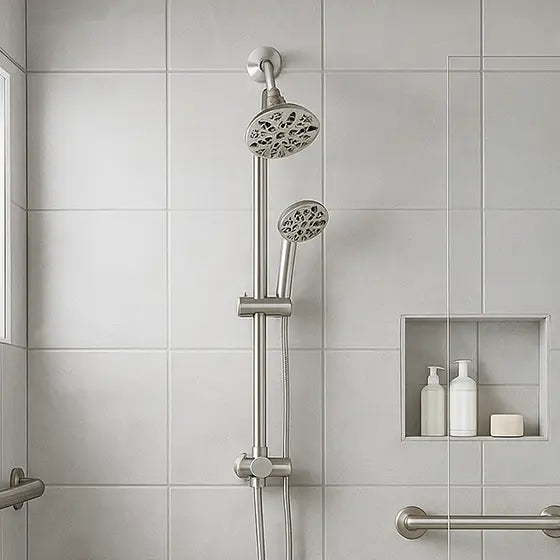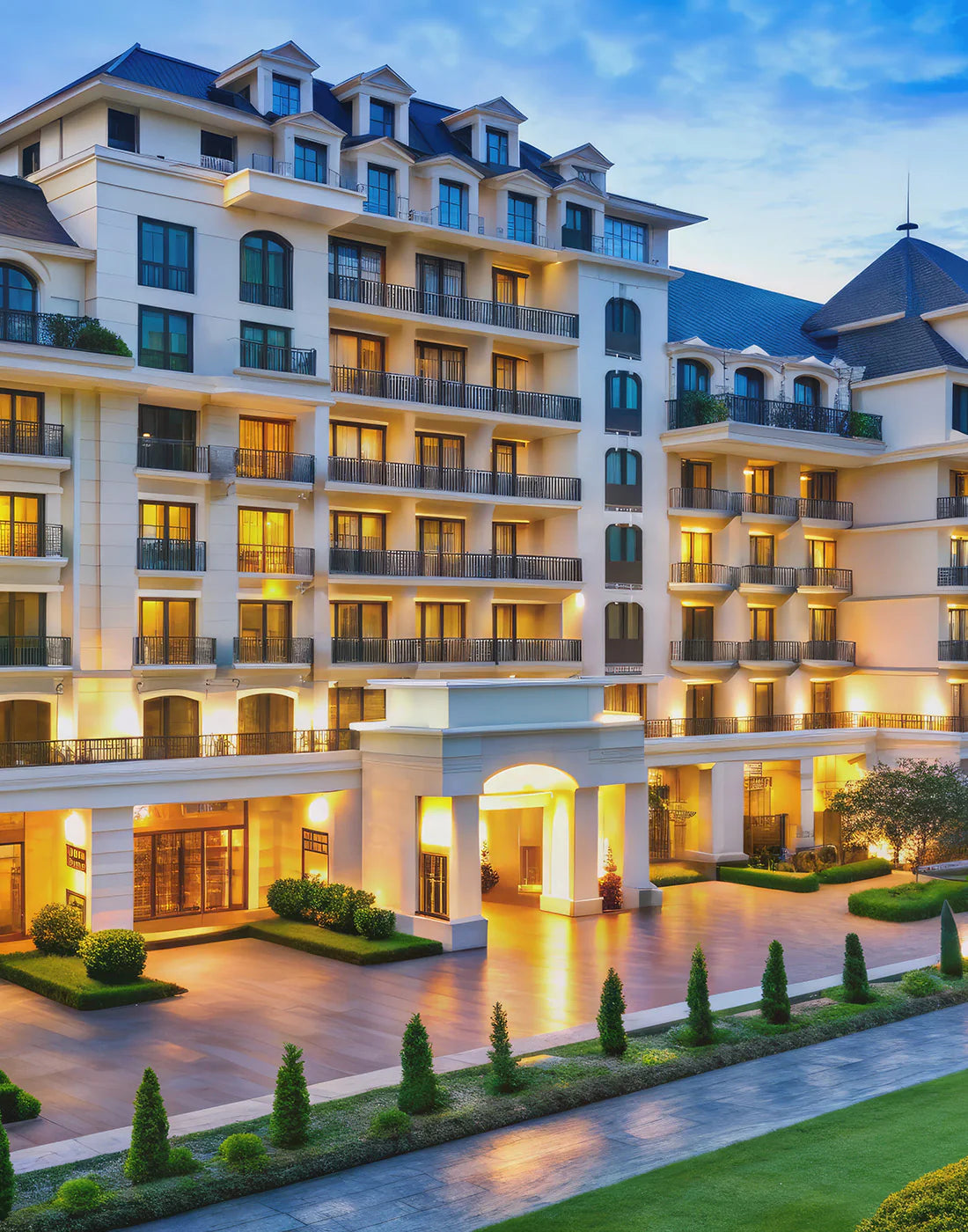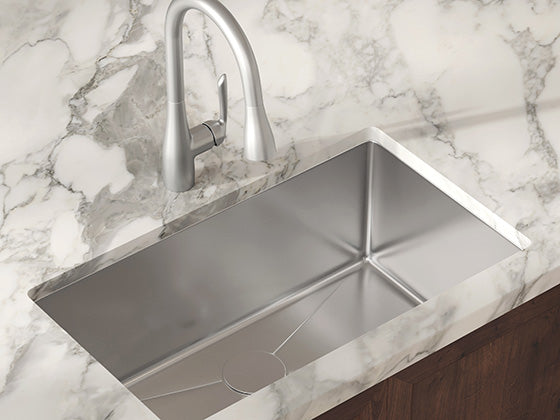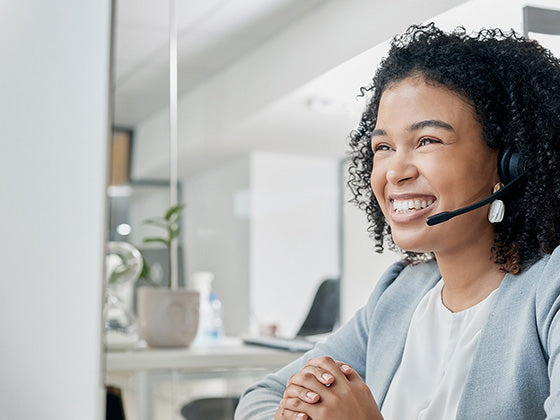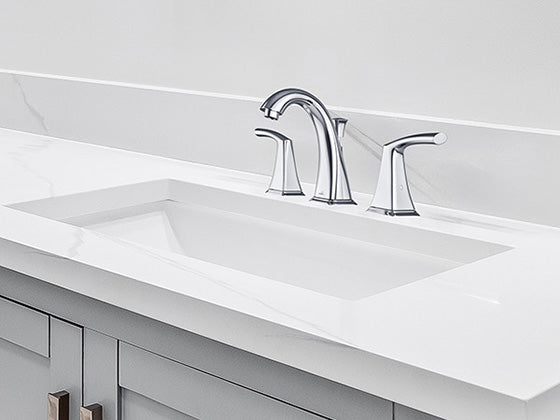- How Can the Right Kitchen Faucet Take Your Design to the Next Level?
- Finishes and Colors - Luxury Kitchen Faucets for Every Budget
- Style Options and Aesthetics
- Functional Features for High-End Kitchen Faucets
- Basic Kitchen Sink Faucet Configurations
- Quality Manufacturing for Lasting Client Satisfaction
How to Build a Faucet List So You Can Give Your Clients Their Dream Kitchen
Kitchens sell homes. And the cornerstone of any high-end kitchen is a beautiful sink with an elegant, functional faucet.
With homeowners and renters becoming more demanding, the right fixtures can help your property stand out from the competition and improve your profits.
For multifamily builds, you may need something affordable and neutral, so residents can customize their unit to their unique tastes.
For new builds in suburban developments, a curated list of unique and luxury options can give homeowners their dream kitchen.
In both cases, knowing how to parse your available options to find the perfect fit will improve your project’s outcome. Plus, it can help you improve your company’s reputation, leading to more success on future bids.
This complete guide will show you how to curate the ideal kitchen faucet list for residential builds so you can offer every homeowner:
- A beautiful kitchen fit for a designer magazine
- A faucet that fits their tastes.
- A functional kitchen sink that’s comfortable to use.
- A range of options for each buyer’s budget.
Let’s get started.
Chapter 1: How Can the Right Kitchen Faucet Take Your Design to the Next Level?


Home buyer demographics have changed drastically since COVID 19. Millennials currently make up the largest share of homebuyers in America.
For builders, choosing the right fixture, including kitchen faucets, matters more than ever before.
How demand for multifamily has changed in recent years
Since 2020, the housing market has split in two major directions. Current house prices are out of reach for many buyers. So multifamily rentals have become appealing for:
.. both of whom would have looked to purchase property in the past.
However, new builds and developments have seen an increase in demand for the same reason. Suburban development projects give many home buyers an affordable way to get their dream home.
In general, more people are looking for attractive properties outside of metro areas. That includes renters looking for multifamily buildings and buyers who want property in a development.
All this comes with higher demands for designs that are comfortable, usable, and stylish. Tastes are constantly changing, and it can be hard to keep up. But one thing always stays the same:
Great kitchens sell homes.


That’s true for custom condos, suburban developments, and multifamily rentals. Beautiful kitchen designs with the right finishes and fixtures increase the value per square foot of any property.
More importantly, functional fixtures that can keep up with your buyer’s lifestyle ensure their long-term satisfaction. And that can mean repeat business for you.
This is especially important if you’re creating a list of customization options for new builds. There is a lot of competition out there, especially in states like Florida, Texas, and California.
Your list of fixtures and finishes could be the key to helping buyers enjoy their dream kitchen in your property for years to come.
So we know the kitchen is important, but why focus on the sink specifically?
Why Kitchen Sinks and Faucets Are So Important to Your Project’s Success
The sink is usually one of the most visible workstations in a kitchen. Depending on the layout, it may even be visible from outside the room.
The sink also sees more consistent day-to-day use than most other areas of the kitchen. It’s where we wash our hands, prepare meals, clean up after cooking, maybe even bathe babies, pretreat laundry, and do other household tasks.
A kitchen faucet is the most visible part of the sink, so it needs to add to the visual appeal of the room, too.
As you create your list of options for prospective buyers, it’s important to understand what different people look for in a kitchen faucet.
What Do Buyers and Residents Want in a Kitchen Faucet?


Maybe you’re looking for the best faucet for a multifamily build. Or you’re creating a list for homeowners to customize their home in a new development. Either way, the goal is the same.
Understanding what people look for in a faucet will help you create a kitchen that’s attractive at first glance and has lasting appeal over time.
- Colors and finishes that add to a warm, welcoming atmosphere.
- Designs that complement the overall look of the kitchen.
- Functional features that make the sink more convenient and versatile.
- Accessible controls that are easy to use.
- A layout that doesn’t waste space or make the sink hard to keep clean.
- Dependable function without maintenance headaches.
That may sound like a lot to ask, but there are thousands of great options out there. How can you ensure every buyer gets exactly what they want without feeling overwhelmed by options?
We’ve organized this guide to follow the typical buyer’s thought process as they consider the options you have available. Each category has a few key points your team should feel confident discussing so they can help your clients navigate the pros and cons of each model.
That way, every buyer feels confident getting exactly what they want. This will help them feel great about choosing you as their builder and improve their long-term satisfaction with the home you build for them.
So where do most homeowners start their search for the right kitchen faucet?
Chapter 2: Finishes and Colors - Luxury Kitchen Faucets for Every Budget
Colors and finishes are probably the last thing on your list as a builder. But it’s usually the first thing clients notice.
Materials and finishes are also major factors in how expensive a faucet is. So it’s a great way to differentiate your list by price point.
We’ve ranked this list starting with the luxury options that are in high demand and working toward reliable cost effective materials.
2.1 Kitchen Faucets in Gold - The On-Trend, Opulent Option


According to the National Kitchen and Bath Association, gold faucets were the top choice for faucet colors in 2024. Almost 50% of respondents ranked it as their top choice this year.
Gold faucets come in various materials, including brass, stainless steel, zinc, and even ABS plastic. Each material has different price points, but generally, gold is considered a luxury color and typically costs more than other colors in the same material.
Faucets made from zinc, brass, or stainless steel are usually the most durable. For faucets at a mid-range price point, we recommend zinc or stainless steel faucets with a gold finish for the perfect marriage of material and finish.
This provides the same opulent appeal as brass without sacrificing quality or longevity. So it’s ideal for builders looking to offer gold fixtures that balance luxury and affordability.
PROS:
- Most in-demand faucet color in 2024
- Adds warmth to the sinks area
- Neutral enough to blend with a wide range of color palettes
- Goes well with a wide variety of sink materials and countertops in other shades
- Adds a unique touch of luxury many homeowners will want
CONS:
- Can be difficult to get an exact color-match with cabinet hardware or gold basins from a different manufacturer
- Won’t go with every design esthetic; tends to look too modern for traditional kitchens
- Slightly more expensive than other colors (although the cost difference isn’t significant if you choose the right manufacturer and materials)
BEST USE:
- Pair a gold faucet with a matching gold basin or mix materials for an elegant look.
- Use with white quartz countertops for a light, airy feel or offset against cool gray granite.
- Add gold hardware to help the faucet blend with the rest of your design.
- Contrast with cooler colors for cabinets for a stylish look.
- Avoid using natural wood tones, which may clash.
2.2 Black Kitchen Faucets - Modern, High-Contrast Appeal


Black is another unique option that neared the top of the list for most in-demand faucet colors this year.
Black kitchen faucets are usually slightly less expensive than gold. But they still tend to cost more than traditional silver or chrome options.
This high-contrast option adds a lot of interest to the sink area and can keep a kitchen from looking too bland or washed out.
PROS:
- Very popular kitchen faucet color with wide appeal
- Adds a pop of contrast that can give the sink a unique look
- Easy to match with other black fixtures and hardware
- Mixes well with black kitchen sinks as well as stainless steel and even fireclay
- Usually have a matte finish, which hides fingerprints better than high-shine materials
CONS:
- Color can fade over time, especially with too much sun or harsh chemicals
- May show dust, hard water, and soap scum more than other faucet colors
- Frequently need extra upkeep and more frequent cleaning than other materials
BEST USE:
- Try to avoid placing beside a window where it will get daily direct sunlight
- Use in modern, minimalist, eclectic, and Scandinavian designs
- Pair with a stainless steel basin, black stainless kitchen sink, or granite composite sink.
- Add black hardware in a similar style to pull the room together.
- Create a moody, masculine aesthetic with dark cabinets and countertops.
- Contrast with brighter counters and cabinet colors.
2.3 Stainless Kitchen Faucets - Timeless Durability


Stainless steel is known for its superior durability. It’s commonly used both in finishes and for internal components in faucet manufacturing.
Stainless steel can be left with its natural finish for a sleek, modern look. With modern techniques, we can add color to stainless steel for a rich, eye-catching appearance.
This versatility, combined with its affordability, makes stainless steel a popular choice for many faucet components.
Because stainless steel is the best and most common sink material, stainless kitchen faucets make an effortless match.
For these reasons, stainless steel ranked higher than brushed nickel on surveys for the most desirable faucet finishes.
PROS:
- Hypoallergenic and always lead-free
- Easy to clean and maintain, especially in a matte finish
- Can withstand extreme temperatures
- Common material that’s easy to source
- Extremely durable and resistant to tarnish
CONS:
- More expensive than other materials that look almost identical
- Although rare, poor quality stainless can develop rust, so make sure to buy all stainless steel faucets from a reputable manufacturer that exclusively uses 304-grade stainless steel
- High polish stainless can be a fingerprint magnet and may show dust, scratches, and stains
BEST USE:
- Include a few stainless steel kitchen faucets on your list for clients looking specifically for that material.
- Pair with a bright backsplash or dark countertops to keep the kitchen from looking bland.
- Add interest with a stainless steel farmhouse sink or contrast with a granite composite basin.
2.4 Brushed Nickel - A Soft Finish That’s in High Demand


Brushed nickel has a subtle, muted shine achieved through a brushing process that creates fine lines on the surface. This texture gives it a soft, matte-like appearance without being truly matte, which gives it an inviting, tranquil feel.
The warm, neutral tone of brushed nickel complements a wide range of kitchen styles, from traditional to modern. It pairs well with various materials such as marble, granite, and wood, making it a flexible choice that can suit almost any kitchen aesthetic.
It often appears very similar to stainless steel, which tends to rank higher on surveys. While stainless steel is also a great choice, brushed nickel faucets are often easier to source. Because it hits the sweet spot for an affordable material that feels luxe, it may end up dominating your list.
PROS:
- Very durable, resistant to tarnish, corrosion, and scratching.
- Doesn’t show fingerprints, scratches, or water spots as easily as high-shine finishes, meaning homeowners won’t have to clean it constantly to keep it looking good
- Blends easily with many color palettes and design schemes
- No special cleansers or maintenance required; easy to maintain
- Easy to source, and comes in a wide range of designs
CONS:
- Variation in shine and tone can make it hard to match precisely with hardware or other fixtures
- Resistant to tarnish, but tarnishes faster than chrome or stainless steel
- Mid-range price point makes it less ideal for multifamily builds with tight budgets
- It’s rare, but some people are allergic to nickel
BEST USE:
- Offer clients brushed nickel faucet options in a range of designs for modern, traditional, retro, and rustic kitchens.
- Choose contrasting options for cabinet hardware and lighting fixtures to avoid slight mismatches. For example, brass or gold for nickel with a warm undertone, and black or enameled options for nickel with a cool tone.
- Pair with cabinets in natural wood finishes or butcher block countertops to create a welcoming atmosphere.
- Contrast with glossy, high-shine countertops.
2.5 Chrome Faucets - High Shine, Low Cost


Chrome faucets have been around for a long time, and will probably always be an option for designers. Chrome finishes come in two main types: polished and brushed.
Polished chrome is the most popular chrome option, known for its high-shine, mirror-like finish. This bright gloss appearance gives a sleek look to any fixture.
Brushed chrome has a softer, matte appearance compared to polished chrome. The slightly-textured finish is created with a wire brush to create fine lines on the surface, which dulls the shine and gives it a textured look.
This finish is less reflective and better at hiding fingerprints and water spots, making it a practical choice for those who prefer a more understated look.
PROS:
- Unbeatable affordability without compromising quality
- Lightweight, easy to ship and transport between build sites
- Good durability and fairly low maintenance
- Versatile and neutral, making it easy to blend with a wide range of designs
- Cooler tone won’t clash with natural wood or warmer color palettes
CONS:
- Slightly more susceptible to stains and scratches
- High shine faucets may show fingerprints, water spots, and dust more than softer finishes
- Require more upkeep to maintain looks over the long term
BEST USE:
- Offer a range of designs to suit many aesthetics, such as modern, industrial, or traditional.
- Add chrome options for high-end features like commercial-style sprayers. That way, you have models within reach at every budget range.
- Look for satin and high-shine options to include on your list.
- Offer to clients who plan to update their kitchen in the future and don’t want to invest in luxury materials.
- Ideal for multifamily builds with a tight budget, or where the faucet will likely be replaced every 10 years or so.
As you can see, finishes and colors are a great place for your clients to start their search for a perfect kitchen faucet.
With the right materials, they can get an eye-catching feature and get an idea of what they can get in their budget range.
Of course, a faucet’s finish isn’t the only thing that affects its look. The next thing your clients are likely to want to look for is a specific style.
Let’s look at those next.
Chapter 3: Style Options and Aesthetics
A faucet’s style determines what kind of design aesthetic it’s best suited for. The style can also influence how comfortable the sink is to use and how well it fits the space.
There are endless options for kitchen faucet designs, so it can be helpful to curate the right list. Your clients may start to feel overwhelmed and uncertain about their choice if there are too many options.
We recommend including a few faucets in each style. Your team can help by being prepared to guide your clients through the pros and cons of each one for their specific kitchen.
3.1 Gooseneck vs. Flat Spout


There are two main categories for faucet designs: gooseneck and flat spouts.
Gooseneck kitchen faucets are tall, and have a dramatic arched spout. They’re ideal for:
- Kitchens with high ceilings
- Sinks that don’t have an overhanging window sill or cabinet nearby
- Deep sinks
A flat spout, on the other hand, is a low-profile option that doesn’t take up much vertical space. They work best for:
- Kitchen sinks under cabinets where a gooseneck might feel crowded
- Smaller basins
ADA kitchens and clients who want a more accessible pull-out sprayer faucet.
Ultimately, the choice between a gooseneck or flat spout comes down to preference. However, it’s important to match the faucet’s reach to your basin so it lines up over the drain to prevent splashing.
The spout height can also be a factor in how comfortable the sink is to use. If the spout sits too low, it may get in the way if the user plans to stack large loads of dishes in the sink. So lifestyle and usage plans may factor into helping your client make the best choice.
3.2 Faucet Styles


There are limitless styles of kitchen faucets to choose from. To keep things simple for your buyer, we recommend offering a couple of options from three main categories:
- Modern. Modern faucets have a minimalist design that’s sleek and streamlined. Their simplicity is appealing for many people because they’re easy to clean and maintain. However, their bold, geometric look may not blend well with more traditional kitchens.
- Traditional. On the other end of the spectrum, you have traditional kitchen faucets. These styles will usually have extra flourishes and details some homeowners love. However, those added nooks and crannies can build up hard water and debris, making them more difficult to keep clean.
- Transitional. Transitional kitchen faucet styles are the perfect middle ground, and will probably make up a large proportion of your list. They’ve got clean, simple lines without looking as severe as many modern faucets.
3.4 Commercial-Style and Industrial Kitchen Faucets


These types of faucets deserve their own section because of their unique blend of functional features with bold aesthetics.
Technically, most commercial-style sprayer faucets fall under the umbrella of transitional styles. But their unique appeal comes from a high-arc spout with an exposed spring coil. Sometimes called prep faucets, or spring faucets, their design mimics the look of faucets used in professional kitchens.
This design is not only attractive and eye-catching. It’s also extremely convenient and ideal for home chefs.
In some cases, the design will include a pull down sprayer and hose, like other pull-down faucets. Other models do not have a retracting hose. Instead, their flexibility comes from the spring itself.
In those cases, your client won’t need to worry about the hose getting tangled or caught up. Plus, the spring prevents issues with a dangling spout that can happen as the docking wears out on a traditional pull-down sprayer.
They look great in a wide range of kitchen designs, from rustic to industrial, and come in most colors and finishes.
Commercial sprayer faucets cost a bit more than other styles, but they pay dividends in convenience and style.
Looks will be top of mind for many clients, but function and features will run a close second.
Next, let’s explore some must-have options for features and add-ons.
Chapter 4: Functional Features for High-End Kitchen Faucets
The way a faucet looks is important to the overall feel of the kitchen.
But when it comes to daily use, getting the right features and add-ons can make or break your client’s long-term satisfaction with their sink.
4.1 Pull Down and Pull Out Kitchen Faucet Sprayers
Spray nozzles make a kitchen sink more convenient to use and easier to clean. In the past, that meant an accessory to the side of the faucet.
However, modern sprayers are usually integrated into the faucet itself. Integrated sprayers look more modern and save space. They’re also faster and easier to install, making them ideal for multifamily builds.
In both cases, a sprayer makes the kitchen sink more functional for everything from washing produce to scrubbing pots and pans. Integrated sprayers are generally very affordable and don’t cost significantly more than a standard faucet.
In fact, they’ve become almost standard in recent years, so the majority of your list will probably have sprayers.
There are two main options for integrated sprayers.
4.1.1 Kitchen Faucets with Pull Down Sprayers


Pull down sprayer faucets have gooseneck designs with a tall, arching spout.
As you saw in section 3.4, commercial style faucets are a type of pull-down faucet.
PROS:
- High neck makes it easier to fill tall jars or pots
- Many people find it more comfortable to use
- Less risk of pulling the sprayer out too far and missing the sink
- More design options available
CONS:
- Less expensive pull-down faucets are prone to a dangling spout as the dock wears out
- Shorter hose than most pull-out faucets (although Allora USA faucets have longer spray hoses than typical, which homeowners love)
- May be difficult to reach for people with disabilities, so not ideal for ADA kitchen sinks
BEST FOR:
- Deep kitchen sinks
- Kitchen designs that call for a gooseneck faucet
- Clients who want more clearance between the faucet at the basin
4.1.2 Pull Out Kitchen Faucet Sprayers


Pull out kitchen faucets have flat spouts that a user can pull horizontally to manipulate the spray nozzle.
PROS:
- Usually have a longer hose than pull-down faucets
- Compact design takes up less vertical space
- Less splashing than with pull-down faucets
- No risk of dangling spout or insecure docking
CONS:
- Less vertical clearance between the sink and the faucet
- May have fewer design options
- User may spray outside the sink if they pull the spout with too much force
BEST FOR:
- Small kitchen sinks; longer hose makes it easy to fill large pots and other vessels on the countertop beside the sink.
- ADA kitchens where the spout needs to be within easy reach from a seated position.
- Kitchens with cabinets or window sills over the sink.
4.2 Rotating Spouts


It’s rare to find faucets without a rotating spout. However, we feel it’s worth mentioning as something to be sure your list includes for a few reasons.
- Double kitchen sinks need a faucet that’s easy to rotate to get full use out of both bowls.
- Your client will probably find themselves in situations where they want to push the faucet out of the way. For example, placing a large bucket or pot into the sink.
- It’s an easy way to direct the water flow across a wider area, which is essential for cleaning the sink.
While most kitchen faucets swivel, there are some designs that don’t. So it’s good to confirm in the design specs for each model you plan to include on your list.
4.3 Faucets for ADA Kitchen Sinks


ADA kitchen sinks have a lot of specific requirements that make them accessible to people with disabilities.
There aren’t as many specifics when it comes to choosing a faucet to go with an ADA kitchen sink. But there are a few things to keep in mind.
- Easy to turn on and off with less than 5 lbs of pressure.
- Convenient to use with one hand.
- All parts and features are easily within reach of someone sitting in a wheelchair.
- Temperature controls that decrease risk of burns.
Taking all of that into account, an ideal faucet for an ADA kitchen sink may look something like this:
- Single handle control (see section 5.2 for the reasoning)
- Lever-style control that doesn’t need to be gripped or twisted
- Pull-out sprayer that’s easy to reach
If your client wants a metered faucet with an automatic shutoff, such as a touchless faucet, be sure it runs for at least ten seconds. Of course, manual faucets are less expensive and more reliable, so in general we recommend sticking with those!
Beyond faucet choice, your team will also need to know how to install it properly for accessible homes. For full details, check out our in-depth article about choosing an ADA kitchen faucet.
4.4 Water Efficient Kitchen Faucets


Today’s homeowners and residents are more eco-conscious than in years past. Even if they’re not, water bills are one of the steadily rising costs of living in many areas.
Especially if your build is in a location that’s prone to droughts, or where water tends to be very expensive, be sure to look for water efficient faucets.
Good air-infusion technology allows a faucet to use less water without sacrificing pressure.
Sprayer faucets are also a great way to improve water efficiency in many cases. By directing the flow exactly where it’s needed, the user can cut down on how much water they need. Plus, most sprayers include an apparatus that increases pressure without significantly increasing demand.
While kitchen faucets don’t currently have a Water Sense standard like bathroom faucets, the EPA recommends water pressure between 1.5-1.8 GPM for more efficiency. Looking for efficient faucets will help your clients use less water and keep their water bills under control.
Once your client has found the look and features they want, you can finalize their selection with the right faucet configuration.
There is a lot of overlap between faucet configuration and style, as the layout of the faucet has a big impact on its look. So if your client feels overwhelmed by their options, it may help to start with the configuration and work backward.
What configurations are available may have a lot to do with the sink basin. So it can be helpful to have your client pick their sink first, before starting their faucet selection.
Let’s take a look at faucet configurations and controls next.
Chapter 5: Basic Kitchen Sink Faucet Configurations
Each type of build may benefit from slightly different faucet configurations. In this chapter, we’ll explain which type of faucet works best in different scenarios, and why.
If you’re building a list for buyers to choose from, you may include models in each type of configuration. Some buyers may go by looks only, not realizing how each affects the functionality of the kitchen. So this will help you walk your client through the pros and cons of each so they won’t have any unpleasant surprises in store.
Let’s jump in.
5.1.1. Single-Hole Kitchen Faucets: The Reliable, Go-To Design for Most Kitchens


A single-hole faucet is the fastest and easiest to install.
It’s also most versatile, and can be used with any sink deck, although you may need hole covers if the deck has extra holes.
If you’re using an undermount basin, single hole faucets eliminate the need to drill extra holes. This will help keep your labor costs down and streamline your installation.
Single hole faucets have a compact, modern design that won’t eat up extra counter space. Which makes them ideal for kitchens with limited counter space.
They also work great in large kitchens with plenty of space. Especially if you choose a gooseneck or commercial-style spout with a lot of height to create balance in larger spaces.
Single-hole faucets are also the best option for long-term client satisfaction. They have fewer parts, meaning they’re easier to clean. They also tend to be more durable for the same reason, saving your client maintenance headaches in the future.
5.1.2 Two, Three, and Four-Hole Faucets


Many three-hole faucets have a spout and two handles that need to be installed separately. This design has a very traditional look that some homeowners may like, so it may be helpful to offer at least one three-hole option.
Three-hole faucets are generally more expensive and harder to install. Plus, they often look too old-fashioned for many builds. They’re not ideal for large multifamily projects where simple installation will help you stay on schedule.
Two and four-hole faucets often come with accessories like soap dispensers or a spray nozzle mounted to one side. While these faucets can be appealing for specific aesthetics, they have many of the same issues as three-hole faucets.
In general, compact designs with integrated features are in highest demand. They fit today’s design trends while giving homeowners multifunctional use that’s easy to maintain.
5.1.3 Wall Mounted Faucets and Bridge Faucets


Wall mounted faucets and bridge faucets can give your client a unique feature that stands out.
However, non-standard faucet designs come with some considerable downsides.
Wall mounted faucets are useful for kitchens with extremely limited space. They don’t take up any counter space at all, meaning you can mount the sink very close to the wall or backsplash.
However, it’s very difficult to access the supply lines to make repairs. They’re also difficult to install and you’ll need to coordinate with your team to use thicker drywall in that area.
Bridge faucets also have a unique look that can add a lot of style to retro or antique kitchen designs. They tend to be easy to install, and come in a variety of configurations.
However, they’re very hard to keep clean because they have lots of nooks and crannies where dirt can accumulate. They also take up unnecessary space and create unusable dead space under the bridge.
Perhaps most importantly, the side of the bridge that contains the hot water line can get extremely hot and lead to burns. So it’s not a good choice for families with young children or people with disabilities.
5.1.4 Faucets for Bar Sinks


If your design includes a secondary sink or a wet bar, your client will also need to choose a bar faucet.
Single hole sinks in a modern style are compact enough to fit comfortably with most bar sinks.
Thinking a little outside of the box, you could also offer centerset lavatory faucets. This is a great two-handle option that’s compact enough to work with a bar sink.
5.2 Kitchen Faucet Handle Configurations
As you’re deciding which installation styles are right for your list, you’ll also need to consider the faucet’s controls.
There are several types of controls for kitchen faucets. Beyond the number of handles, there are also different styles of controls.
For example, a modern faucet with a gooseneck spout could have a joystick to one side that can tilt as well as turn. Or, you could have a flat spout with a lever on top, which can be lifted and lowered.
In general, look for controls that make the faucet as easy to control as possible.
Let’s look at the pros and cons of different handle configurations.
5.2.1 Single Handle Kitchen Faucets


We recommend single handle kitchen faucets for most kitchens, unless your client specifically prefers a two-handle faucet. There are several reasons for this.
- ADA compliance. Faucets for ADA kitchen sinks need to be easy to turn on and off with one hand, using less than 5lb of pressure, without twisting, pinching, or tight gripping.
- Accessibility. Even for able-bodied residents, single handle faucets guarantee the sink is easy to use for everyone in the household. This is especially important for elderly homeowners or people who want a home where they can confidently age in place.
- Hygiene. Many people prefer a faucet they can turn on and off with a wrist or forearm. This makes the sink more hygienic, so users won’t contaminate the sink if they’re handling raw meat, for example.
- Safety. Like bridge faucets, two-handle faucets can lead to burns if a user only turns on the hot water. This is much less likely to happen with a single handle faucet, which automatically mixes the supply lines.
- Affordability. Single hole, single handle faucets tend to be more affordable. Which is a great way to put luxury finishes and features within reach for different budgets.
- Ease of installation. Single handle faucets make installation much faster and easier, which will help your team stay on deadline and keep labor costs down.
- Ease of maintenance. Single handle faucets have fewer moving parts, so they’re less likely to cause maintenance headaches.
As you can see, there are plenty of practical reasons to choose a single handle faucet.
It’s also worth mentioning that these designs make better use of space (like any single-hole faucet) and suit modern aesthetics better than two-handle faucets. That makes them a win-win in terms of style and function.
5.2.2 Double Handle Kitchen Faucets


In some cases, you may have a client that strongly prefers the look of a traditional double handle faucet. So it’s worth finding a few models to offer.
Double handle faucets work best for large kitchens with plenty of counter space. They also create a more balanced look for wide sinks where a slim, single handle faucet might look too small.
They’re best for traditional designs with classic appeal.
Functionally, the main benefit of a double handle faucet is that if one handle breaks, the faucet may still be usable until repairs can be made.
While they sometimes allow more precise control over water temperature, most users find single handle faucets easier and more convenient.
For multifamily projects, double handle faucets may be too complicated and time-consuming to install. If your property has hundreds of units, every extra piece can drive up your labor costs.
To sum up, the best faucet configuration for most projects will be:
- Single hole
- Single handle
- Deck mounted
Now that your client has plenty of options to choose from, there’s one more way to guarantee they will love their kitchen sink for years to come. Make sure every model on your list is made with precision and high-quality materials.
Here are a few ways Allora USA can help you deliver lasting beauty and reliability so your clients can love their homes for years to come.
Chapter 6: Quality Manufacturing for Lasting Client Satisfaction
Hopefully this guide has given you a good starting point for curating a list of faucets to fit every budget, design aesthetic, and lifestyle.
High-caliber manufacturing with quality materials is the best way to ensure your client gets fixtures that last. Precision fabrication guarantees smooth, reliable function. It’s also the best way to avoid finishes that flake, chip, or lose their looks, which can make homeowners regret their decision.
Once your client chooses their fixtures and finishes, the last thing you need is to find out their picks are no longer available.
That’s where Allora USA can help!
We offer guaranteed stock, so you know you can get what you need on time without worrying about supply chain issues. Plus, our warranties and money-back guarantee ensure you’ll get the perfect fit for your design and lasting quality for your clients.
We specialize in professional support for builders, designers, and purchasing managers for multifamily projects. We’ve got options to suit every budget and design.
To make things even easier, we provide standard and ADA options in one convenient place. Buying ADA fixtures from a reputable manufacturer means getting products that meet regulatory and quality standards.
Plus we offer:
- Discounts for commercial projects.
- Guaranteed pricing.
- Product warranties.
- Fast customer support
- Free shipping to most areas in the US.
- Delivery within 5 days or less anywhere in the US.
- Unlimited phone and email support.
Ready to get started?
You can filter through the amazing variety of faucet options. You can even hone your search with specifics like what finish or style you’re looking for. Or look through our catalog for a full list of options and alternatives.
Or, send us your specs and we’ll put together a list of options that will fit your project. We can set you up for ongoing care for all your builds, so you can get great fixtures every time without wasting hours searching for what you need.




